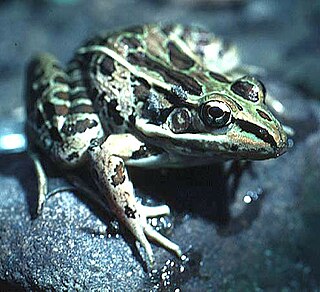The multi-coloured tree frog or multi-coloured frog is a species of frog in the subfamily Pelodryadinae. It is endemic to West Papua, Indonesia. Its natural habitats are subtropical or tropical moist lowland forests, subtropical or tropical moist montane forests, swamps, and freshwater marshes. It is threatened by habitat loss.

Phlyctimantis maculatus is a species of frog in the family Hyperoliidae. They are silvery greyish-brown with dark brown to black spots, and derive their name from bright red coloring on the ventral side of their hind legs. Adult body length is typically 6 to 7.5 centimeters. These frogs have vertical pupils. Common names include red-legged running frog, brown-spotted tree frog, red-legged Kassina, red-legged pan frog, spotted running frog, tiger leg running frog, and vlei frog.
The Giant Visayan frog is a species of frog in the family Dicroglossidae. It is endemic to the Philippines, and is known from Masbate, Cebu, Negros, Guimaras, Panay, and Siquijor islands.
The Chaochiao frog is a species of frog in the family Ranidae, found in China and possibly in Myanmar and Vietnam. Its natural habitats are temperate forests, subtropical or tropical moist montane forests, subtropical or tropical high-altitude shrubland, subtropical or tropical high-altitude grassland, rivers, swamps, freshwater lakes, freshwater marshes, intermittent freshwater marshes, ponds, irrigated land, and canals and ditches. It is not considered threatened by the IUCN.

The common green frog is a frog species of in the true frog family Ranidae; some sources still use the old name Rana erythraea. It lives in Southeast Asia and is also known as green paddy frog, red-eared frog or leaf frog. The last name, however, commonly refers to the Neotropical tree frogs which make up the subfamily Phyllomedusinae. These are not closely related to H. erythraea, belonging to family Hylidae instead.

Forrer's grass frog or Forrer's leopard frog, Lithobates forreri, is a species of frog in the family Ranidae found in Mexico and Central America through Guatemala, El Salvador, Honduras, and Nicaragua to Costa Rica. It is a widespread and common frog found in lowland and seasonal tropical forests. It can also adapt to man-made habitats such as flooded agricultural lands and other water content systems. Reproduction requires permanent pools and lagoons.
Moore's frog is a species of frog in the true frog family (Ranidae). It is endemic to the Sierra Madre Oriental of Mexico.
The Maya Mountains frog is a species of frog in the family Ranidae found in Belize and possibly Guatemala. Its natural habitats are subtropical or tropical moist lowland forests, moist savanna, and rivers. This anuran is found primarily in the Mayan Mountain region between 100m and 915m of elevation.
The island leopard frog or Little Corn Island frog is a species of frogs in the family Ranidae, endemic to Little Corn Island off the Caribbean coast of Nicaragua. It is locally known as rana leopardo isleña.
The smooth-backed frog is a species of frog in the family Ranidae endemic to Mexico.
The Puebla frog or Pueblan pool frog, Lithobates pueblae, is a species of frog in the family Ranidae endemic to Necaxa River near Huauchinango, Puebla state, Mexico, where it is known as rana poblana. It was thought to probably be extinct until 2010 when Dr. Georg Hantke from the National Museum of Scotland re-discovered it.
The Mexican cascades frog or white-striped frog is a species of frog in the family Ranidae endemic to Mexico, where it is known as rana de cascada.

The showy leopard frog is a species of frog in the family Ranidae endemic to Mexico.

Vaillant's frog is a species of frog in the family Ranidae found in Central America. Its natural habitats are subtropical or tropical dry forests, subtropical or tropical moist lowland forests, subtropical or tropical swamps, rivers, swamps, freshwater lakes, intermittent freshwater lakes, freshwater marshes, intermittent freshwater marshes, rural gardens, heavily degraded former forests, water storage areas, ponds, and canals and ditches.

Zweifel's frog is an amphibian species endemic to Mexico. It is a member of the true frog family, Ranidae.

Chirixalus doriae, commonly known as Doria's Asian treefrog, Doria's bush frog, Doria's bush frog, and Doria's tree frog, is a species of frog in the family Rhacophoridae. It is found in southeastern Asia, from extreme northeastern India and adjacent Bangladesh to Myanmar, Thailand, Cambodia, Laos, Vietnam, and southern China.

Pseudophilautus cavirostris, commonly called Hollow-snouted shrub frog, is a species of frog in the family Rhacophoridae. It is endemic to Sri Lanka.
Pseudophilautus decoris, commonly known as the elegant shrub frog, is a species of frogs in the family Rhacophoridae. It is endemic to Sri Lanka.
Pseudophilautus procax, known as Cheeky Shrub Frog is a species of frogs in the family Rhacophoridae.
The Faro Island tree frog, also known as Solomon Islands treefrog, is a species of frog in the subfamily Pelodryadinae. It is found in Papua New Guinea and Solomon Islands. Its natural habitat is subtropical or tropical moist lowland forests. It is threatened by habitat loss.









